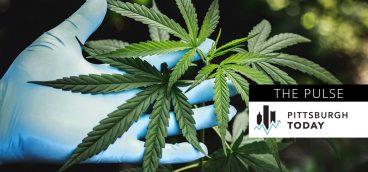Is Cannabis Safe and Effective?

Antoine Douaihy is intrigued by the use of marijuana to treat chronic pain. As an addiction specialist, he’s keenly aware of the value of safe and effective alternatives to prescribing opioids. Several studies suggest pot could be one, at least with some patients, and pain is one of 21 state-approved conditions that get you a medical marijuana card in Pennsylvania. But as a doctor, he’s troubled by the missing pieces of the puzzle. And there are many, including answers to basic questions, such as how much relief does pot offer, for what type of pain and at what dose?
The story is similar for most other conditions covered under state medical marijuana programs. “You have the potential for marijuana to help in certain conditions, but we don’t have enough studies and strong evidence to know for sure,” said Dr. Douaihy, professor of psychiatry and medicine at the University of Pittsburgh and academic director of addiction medicine services.
Legalization of marijuana is spreading among U.S. states, outpacing the effort of science and government to fully understand its medical effectiveness, and impact on public health and safety.
Medical marijuana is now legal in 33 states and 10 states and the District of Columbia have legalized pot for recreational use among adults. Yet, it’s still unclear how legalization will affect usage rates in the long term or whether it will cause more traffic accidents and fatalities.
Treating what ails you
The potential of marijuana to help patients with conditions ranging from chronic pain, arthritis and epilepsy to insomnia and the affects of chemotherapy is seen as one of the key reasons for the dramatic shift in public opinion in favor of legalizing cannabis.
A recent Quinnipiac University poll found that American voters favor legalizing marijuana for all adults by 63 percent to 33 percent. They support legalized medical marijuana by a 93 percent to 5 percent margin, despite the fact the U.S. Food and Drug Administration hasn’t approved pot as a treatment for most medical conditions.
Research on cannabis as a medical treatment is thin. A major reason why is that marijuana, like heroin, is classified as a federal Schedule 1 controlled substance with no accepted medical use and a high potential for abuse. As such, the Drug Enforcement Agency tightly restrict access to cannabis and how it is used, making research difficult. Few clinical studies with patients have been done on cannabis treatments as a result.
Anecdotal evidence and existing research suggest its potential to help patients suffering from certain conditions. Small-scale studies, for example, have reported that cannabis helps reduce diabetic neuropathy pain. Research, including clinical trials, found certain types of childhood epilepsy could be effectively treated with cannabidiol (CBD), a chemical compound found in marijuana. The FDA approved its use to treat those conditions last year.
RAND, in the largest study of pot’s role in reducing opioid deaths, found that deaths fell in states where dispensaries made buying medical marijuana easy for patients, but didn’t decline in states where rules for sales were tightened. In Illinois, patients with a doctor-certified condition that could warrant prescribing opioids, such as pain, now automatically qualify for the state medical marijuana program to explore pot as an option.
Missing pieces
Marijuana contains more than 400 chemicals and 66 unique chemical compounds. The best known, tetrahydrocannabinol (THC) is the primary psychoactive ingredient that gets users “high.” CBD on the other hand is not intoxicating. Moreover, there are nearly 800 marijuana strains, each having different chemical profiles and effects.
With such a complex plant and so few clinical studies, much remains to be learned about how patients respond to marijuana as a treatment for many conditions, including those approved by that state. One is opioid addiction, which Pennsylvania was the first state to add to its medical marijuana program.
“We have medications that are effective for the treatment of opioid addiction. We can’t say we are going to use medical marijuana as a first-line treatment,” Dr. Douaihy said. “The evidence is weak, anecdotal. You hear of people using marijuana to wean themselves off of opioids, but others don’t do well at all. Keep in mind, marijuana has its own addictive potential, which can complicate its usefulness as a treatment for opioid addiction. So, we just don’t know.”
Pennsylvania last year approved eight universities to conduct clinical research on the medical use of marijuana, including the University of Pittsburgh.
What is clear is that for marijuana users, legalization has led to a better quality, safer and more transparent product than what’s on the street. “An advantage patients have is they know when the product was cultivated, processed and who did it,” said Patrick Nightingale, executive director of the Pennsylvania Medical Cannabis Society. “They know it’s fresh, tested, pesticide-free and what is on the label is what’s in the product. You don’t get that in the black market.”
Public safety concerns
Whether legalizing marijuana makes roads and highways less safe for motorists is a critical public safety question that has yet to be conclusively answered.
A recent study published in the American Journal of Public Health reports that three years after recreational marijuana was legalized in Washington and Colorado, changes in the overall number of traffic fatalities in those states were not statistically different than in other states where pot was not legalized. But Washington and Colorado have each seen an increase in traffic fatalities that involve drivers with traces of pot in their body.
Public officials in both states, however, say it’s unclear how many of those accidents were caused by marijuana intoxication. In many cases, alcohol or other drugs were also involved. Moreover, finding traces of marijuana in the body does not indicate a driver was intoxicated by the drug or impaired. While marijuana intoxication can last a couple of hours, traces of pot can be detected long afterward, sometimes for weeks or a month or longer. And police don’t have a roadside test for drivers to determine marijuana intoxication like they do for alcohol.
Another concern is whether legalization will increase the number of people who use it, particularly adolescents who may be inclined to try it but whose brains are still developing and the risk of harm is greater.
Marijuana use among adults has risen in states following legalization. But RAND researchers report those trends haven’t generally been seen among younger populations. In Washington, the state’s youth health surveys suggest that from 2002 to 2016, marijuana use rose slightly from 25 percent to 26 percent among 12th graders, but fell from 18 to 17 percent among 10th graders and from 10 to 6 percent among 8th graders. Pot was legal for both medical and adult recreational use during the last four years of that period.
Legalizing pot for adult recreational use, however, is a recent experiment that 40 states have yet to attempt. As with questions about medical cannabis, definitive answers about how Americans will handle it are elusive, and for the same reason. “It’s too early to determine whether full legalization will lead to more widespread use,” Dr. Douaihy said. “We don’t have the data.”





